“I’m 11 years older now. Brett, I just can’t have a repeat of 2008,” my new subscribers often share.
“Now tell me which of these dividends will survive a bear market like that. I want to buy only the safest yields,” they continue.
Fortunately I’m no stranger to dividends that thrive in bear markets. We fittingly launched the Contrarian Income Report months before the market’s tantrum in 2016. The S&P 500 promptly dropped 10% as a welcome present!
It was no problem for our strong dividends, however. In fact, subscribers who focused on their own holdings rather than the financial news likely have missed the broader carnage altogether. Our core bond fund holdings (orange, red and green lines below) not only continued to pay their 7% dividends, but they also averaged a 5% price gain while stocks were swooning:
What Pullback? Contrarian Bond Funds Sail
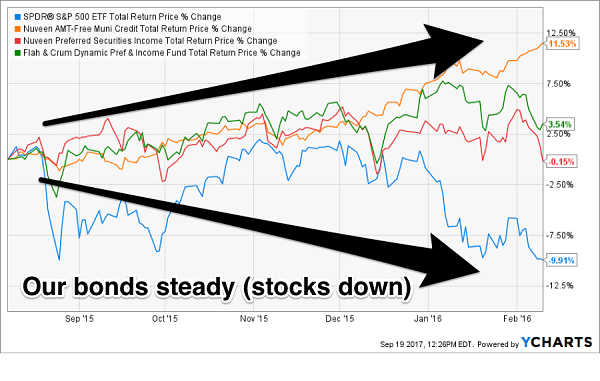
What about a trade war? Let’s rewind to the last time protectionism flared in America, 17 years ago, to see how some of our stocks and funds performed during the last trade tiff.
On March 20, 2002, President George W. Bush whacked steel imports with tariffs ranging from 8% to 20%. The duties stayed in effect until December 4, 2003. The European Union was unamused and hit back with tariffs of its own.
So what happened to the S&P 500 during the last tariff tantrum? It dropped 4.3% during the 21-month period (orange line in the chart below). But many stocks did fine, and many of our Contrarian Income Report holdings simply hummed along. In fact, four of our stocks and funds saw the trade drama firsthand–and simply shrugged it off for an average return of 42.1% including dividends!
No Withdrawal Favorites Had No Problem with Tariffs
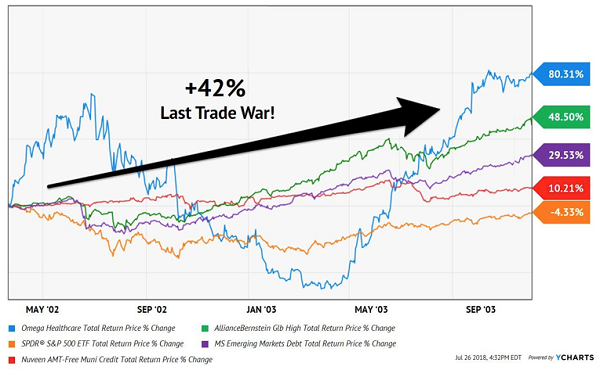
This four-pack generates its income (and 6.2% yields) from skilled-nursing facilities, high quality municipal bonds and underappreciated overseas credit. It won’t matter what happens between the US and China. These stocks and funds won’t have their cash flows interrupted, which means their dividends and prices will be just fine.
(It’s buys like these that have helped my subscribers to 10.6% annualized gains since inception. Most of these profits have come in the form of cash dividends. Our retirement portfolio is the ultimate “absolute return” vehicle.)
Carefully curated bond funds should repeat their resilience during the market’s next pullback (whether it’s right now, or still to come). And honestly, it shouldn’t matter to you with a true “no withdrawal” portfolio that lets you focus entirely on dividends and ignore price action altogether. Here’s why.
We Avoid Reverse Dollar Cost Averaging
Most investors practice “buy and hope” investing. They pick up shares and root for them to appreciate in price. And that’s it.
These first-level types have no plan on how to generate cash flow from their holdings. They think they’ll sell someday, and hope it’s at a higher price. But they don’t have a set game plan to sell and methodically collect regular, sustainable cash payments from their portfolios.
Many financial advisors step into this void, pitching a “4% withdrawal rate.” These guys (who have not retired successfully themselves, by the way) say that you can safely withdraw 4% or so every year from your portfolio and use this as spending money.
Generally, they’re right. But when they’re wrong, it’s disastrous.
The fatal flaw with the 4% annual withdrawal strategy for retirement is that every few years, you’re faced with a chart like this:
Selling Here is Reverse Dollar Cost Averaging
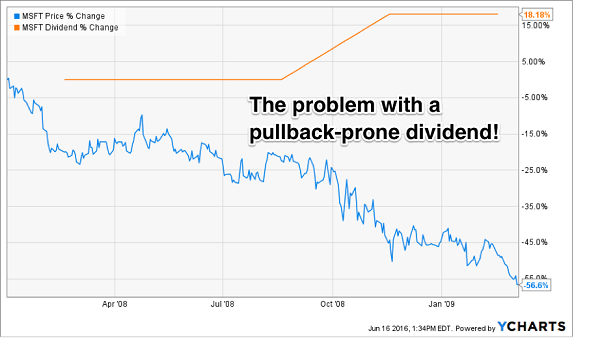
Investors who practiced the 4% withdrawal “strategy” with Microsoft shares were forced to take out money at exactly the wrong time. If they didn’t have enough dividend income to support themselves at the time, they had to sell even more shares for additional income.
Sadly, this is reverse dollar cost averaging–selling even more shares when prices are low, which reduces upside when markets normalize. This is the same phenomenon that built your wealth, except now it works against you!
The solution is to transition away from ever having to sell a share. And pullback-proof dividends of 6%, 7% or 8% are a great solution. They give you a means to collect regular, secure cash from your nest egg on a monthly and quarterly basis, without being forced to sell low (or sell ever).
In fact, you can do even better–you can step in and add money (and reinvest dividends) when prices are low and yields are high.
Because Upside Matters, Too
You’ve probably been told you should dump—or at least reduce—your stock holdings and focus on fixed-income investments as you near and enter retirement. It sounds like a smart move, but going lean on stocks leaves you open to three big risks:
- Outliving your savings,
- Missing out on the long-term gains only the stock market can offer. And, of course,
- Inflation.
So why not blend a portfolio of 7%+ bond funds with smart stock picks that provide you with similarly high yields with upside to boot? Sure, they may “sell off” a bit if the markets pull back. But who cares. Like a savvy rich investor, you’ll be able to step in and buy more shares when they are cheap – without having to worry about your next capital withdrawal.
Let’s take healthcare landlord Omega Healthcare Industries (OHI). The firm’s payout is usually generous, and always reliable—yet, for whatever reason, its sometimes-manic price action gives investors heartburn.
But it shouldn’t. It’s actually quite predictable. Check out the chart below, and you’ll notice:
- When the stock’s yield is high (orange line), its price is low. Investors should buy here.
- When the stock’s price is high (blue line), its yield is low. Investors should hold here, and enjoy their dividend payments.
Investing is Easy: Buy When Yield (Orange Line) is High
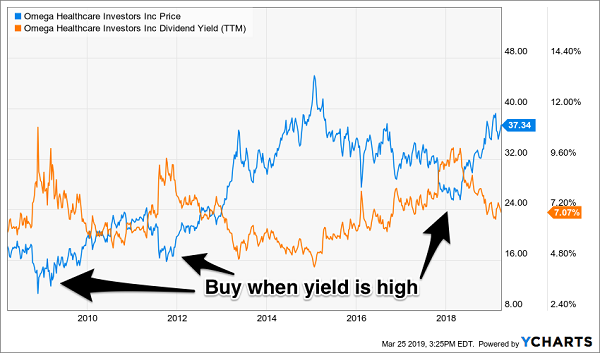
Today OHI’s yield is neither opportunistically high nor offensively low. It’s a respectable “hold” in a high yield portfolio. If yield curve or tariff or recession fears drive the price lower, I would recommend buying more shares at their higher yield without hesitation.
On the other hand, the recent “market froth” prompted me to sell one of our favorites. Fellow landlord Medical Properties Trust (MPW) is about as recession-proof and pullback-proof as it gets. The firm provides financing to hospitals and pays most of its profits to investors.
As with OHI, MPW’s stock price and yield are usually mirror images of each other:
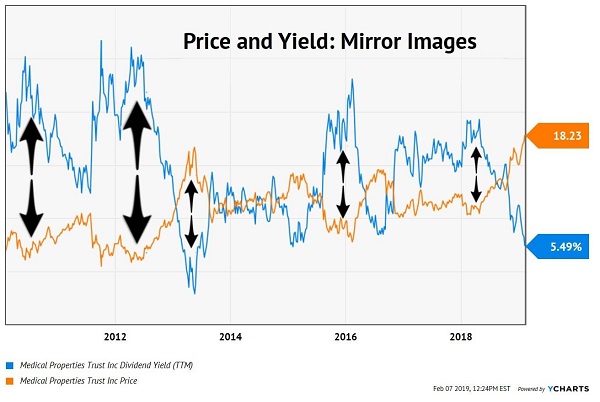
With its yield near its all-time lows, it made sense to sell (and book our 109% total returns). Even the sleepy high yield space can experience mild bouts of irrational exuberance! Fortunately there are investments with more price upside that will actually give us a raise to boot (from 5.5% to 7.4% dividends).
Introducing the “2008-Proof” Income Portfolio Paying 7.5%
The “cash or bear market” no-win quandary inspired me to put together my 5-stock “2008-Proof” portfolio, which I’m going to GIVE you today.
These 5 income wonders deliver 2 things popular dividend pretenders never could, such as:
- Rock-solid (and growing) 7.5% average cash dividends (more than my portfolio’s average).
- A share price that doesn’t crumble beneath your feet while you’re collecting these massive payouts. In fact, you can bank on 7% to 15% yearly price upside from these five “steady Eddie” picks.
With the Dow regularly lurching a stomach-churning 1,000 points (or more) in a single day during pullbacks, I’m sure safe—and growing—7.5% every single year would have a lot of appeal.
And remember, 7.5% is just the average! One of these titans pays a SAFE 8.5%.
Think about that for a second: buy this incredible stock now and every single year, nearly 9% of your original buy boomerangs straight back to you in CASH.
If that’s not the very definition of safety, I don’t know what is.
These five stout stocks have sailed through meltdown after meltdown with their share prices intact, doling out huge cash dividends the entire time. Owners of these amazing “pullback-proof” plays might have wondered what all the fuss was about!
These five “pullback-proof” wonders give you the best of both worlds: a 7.5% CASH dividend that jumps year in and year out (forever), with your feet firmly planted on a share price that holds steady in a market inferno and floats higher when stocks go Zen.
